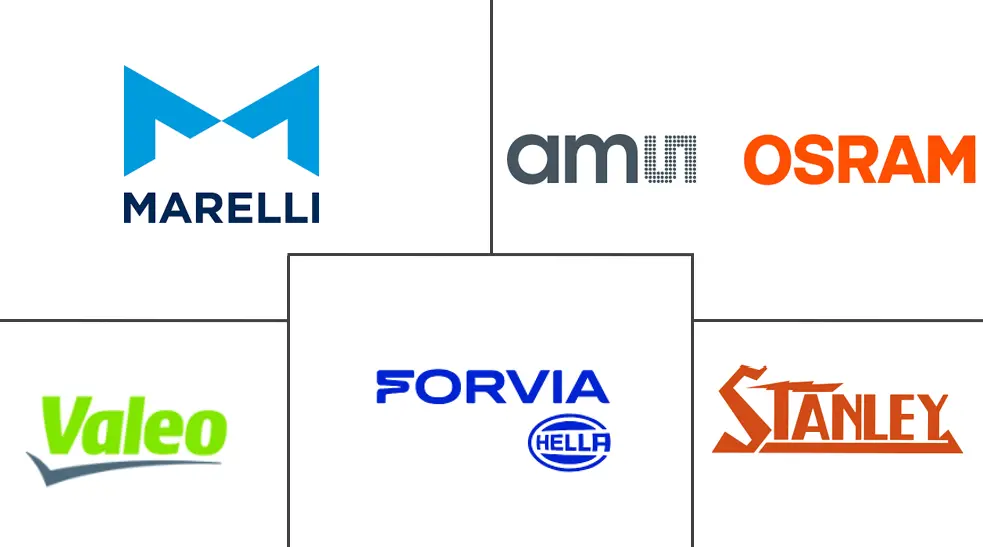Asia-Pacific Automotive LED Lighting Market Size and Share
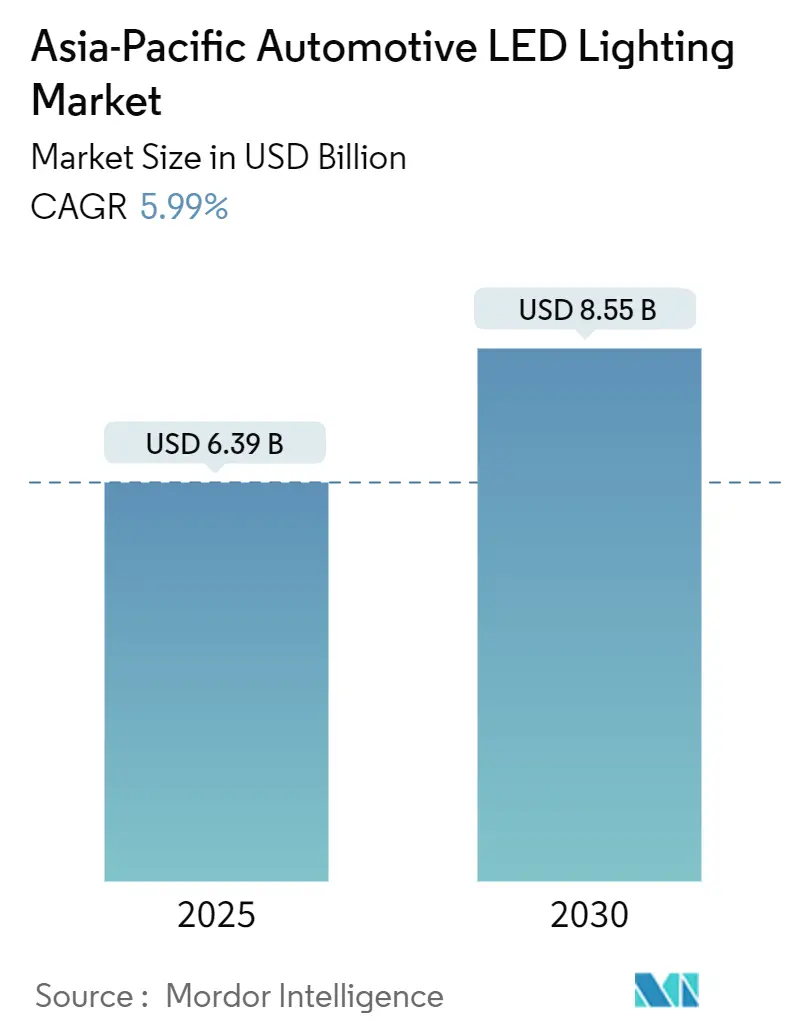
Asia-Pacific Automotive LED Lighting Market Analysis by Mordor Intelligence
The Asia Pacific automotive LED lighting market size stood at USD 6.39 billion in 2025 and is projected to reach USD 8.55 billion by 2030, advancing at a 5.99% CAGR. Accelerated electrification mandates, UNECE R149-driven adaptive-beam requirements, and government incentives for domestic semiconductor packaging collectively underpin the steady expansion of the Asia Pacific automotive LED lighting market. China’s scale advantages, India’s two-wheeler electrification momentum, and Japan’s premium adaptive designs set the competitive tempo, while ASEAN production relocations sustain cost competitiveness. Improved thermal-management designs, falling LED cost per lumen, and software-defined lighting architectures further widen the technology gap against halogen. Meanwhile, aftermarket plug-and-play kits, rising demand for immersive cabin lighting, and resilient semiconductor supply chains reinforce the long-term attractiveness of the Asia Pacific automotive LED lighting market.
Key Report Takeaways
- By application, interior lighting posted a 9.34% CAGR, outperforming exterior systems that dominate revenue today.
- By sales channel, the aftermarket segment grew at 7.22% CAGR to 2030, contrasting with OEM growth in mature premium segments.
- By vehicle type, passenger cars accounted for 68.53% of the Asia Pacific automotive LED lighting market size in 2024 as two-wheeler electrification accelerates incremental demand.
- By installation type, new installations held 61.37% share in 2024, while retrofit solutions are projected to advance at a 6.75% CAGR through 2030.
- By geography, China commanded 35.84% of the Asia Pacific automotive LED lighting market share in 2024 while India is forecast to expand at a 9.65% CAGR through 2030.
Asia-Pacific Automotive LED Lighting Market Trends and Insights
Drivers Impact Analysis
| Driver | (~) % Impact on CAGR Forecast | Geographic Relevance | Impact Timeline |
|---|---|---|---|
| Vehicle-safety and efficiency regulations | +1.2% | Japan, India, ASEAN | Medium term (2-4 years) |
| Declining automotive LED cost per lumen | +0.8% | India, ASEAN | Short term (≤2 years) |
| Rapid electrification of vehicles | +1.5% | China, India, ASEAN | Long term (≥4 years) |
| OEM race toward ADAS-ready ADB headlamps | +0.9% | Japan, South Korea | Medium term (2-4 years) |
| Ambient lighting in premium two-wheelers | +0.3% | India, ASEAN | Long term (≥4 years) |
| Local LED packaging incentives | +0.7% | China, India, ASEAN | Medium term (2-4 years) |
| Source: Mordor Intelligence | |||
Stringent Vehicle-Safety and Lighting-Efficiency Regulations Drive Technological Convergence
UNECE R149, India’s AIS-008, and updated Japanese inspection norms compel OEMs to migrate from halogen to matrix-LED systems. Export-oriented manufacturers must now standardize glare-control algorithms, photometric testing, and adaptive-beam compliance across multiple markets, streamlining the supply chain while raising the technology entry bar. Certification capacity has become a differentiator; suppliers with accredited laboratories win programs sooner and at lower validation cost. As regulators tighten glare metrics, adaptive driving beam adoption in the Asia Pacific automotive LED lighting market accelerates, cementing LEDs as the lighting technology baseline. [1]Automotive Research Association of India, “AIS-008 Standard for Automotive Lighting Systems – 2024 Update,” araiindia.com
Declining Cost per Lumen Transforms Market Economics
High-volume wafer fabs in Taiwan, packaging houses in China, and automated assembly lines in Japan have cut cost per lumen sharply, enabling mainstream B-segment cars and light commercial vehicles to upgrade affordably. Fleet operators now calculate sub-18-month payback windows from reduced bulb replacements and lower electrical loads. Patented copper-substrate and heat-pipe designs registered in 2024 further lengthen service life, reducing warranty exposure. Consequently, price-sensitive India and ASEAN markets narrow the technology gap, scaling the Asia Pacific automotive LED lighting market across all trim levels. [2]Japan Patent Office, “Patent Applications – Automotive LED Thermal Management Technologies Filed in 2024,” jpo.go.jp
Rapid Electrification Creates Systemic Demand for Efficient Lighting
Electric powertrains magnify every watt saved. With Chinese EV lines surpassing 85% LED penetration in 2024, OEMs integrate lighting with battery management to maximize range. Two-wheeler brands such as Hero Electric and Ather Energy standardize LEDs to meet daily-commute distance expectations. As vehicle architectures become software-defined, programmable LEDs facilitate V2X messaging, dynamic signatures, and over-the-air updates that extend vehicle value, reinforcing demand inside the Asia Pacific automotive LED lighting market.
OEM Race Toward ADAS-Ready Adaptive Driving Beam Technology
Koito, Stanley, and Samsung LED showcased 10 000-pixel ADB prototypes in 2024, delivering razor-sharp cut-offs that protect oncoming traffic while illuminating road edges. Integration with front cameras unlocks glare-free high-beam usage, a valuable safety differentiator. Early regulatory approvals in Japan and South Korea set a regional precedent, propelling ADAS-ready headlamps deeper into mid-range cars by 2026. Patent data indicates a surge in beam-shaping algorithms that marry lighting control with sensor fusion, supporting Level 3 autonomy initiatives within the Asia Pacific automotive LED lighting market.[3]Stanley Electric Co., Ltd., “Stanley Electric Demonstrates Next-Generation Matrix LED Technology,” stanley.co.jp
Restraints Impact Analysis
| Restraint | (~) % Impact on CAGR Forecast | Geographic Relevance | Impact Timeline |
|---|---|---|---|
| Upfront cost of OLED & matrix-LED modules | -0.7% | Global, price-sensitive | Short term (≤2 years) |
| Thermal-management challenges | -0.4% | ASEAN tropics | Medium term (2-4 years) |
| Regulatory pushback on glare | -0.3% | Japan, South Korea | Medium term (2-4 years) |
| Semiconductor supply disruptions & rare-earth risks | -0.6% | China-centric chains | Short term (≤2 years) |
| Source: Mordor Intelligence | |||
Higher Upfront Costs Create Adoption Barriers
OLED panels and micro-LED arrays still cost multiples of conventional LEDs. Entry-level passenger cars and commercial fleets in India continue to favor basic reflector LEDs. The price gap narrows gradually, yet budget-constrained operators defer upgrades, moderating growth in the Asia Pacific automotive LED lighting market. In two-wheelers, lighting can constitute 8–10% of ex-factory cost, further limiting premium module uptake.
Thermal-Management Challenges Constrain Performance
Compact styling trends yield tighter headlamp envelopes. In humid Southeast Asian climates, ambient temperatures exceed 35 °C, accelerating lumen depreciation. IEEE studies show lifespan reductions of 30% without active cooling. Suppliers now co-design vapor-chamber substrates, liquid cold plates, and high-conductivity polymers, but these escalate bill-of-materials. Failure to balance heat versus cost restrains adoption breadth within the Asia Pacific automotive LED lighting market.
Segment Analysis
By Sales Channel: Aftermarket Retrofits Outpace OEM Rollouts
OEM installations accounted for 82.12% of the Asia Pacific automotive LED lighting market size in 2024. Yet retrofit kits are racing ahead at 7.22% CAGR as vehicle owners prolong lifecycles, leveraging simplified plug-and-play modules that match factory connectors and integrate CAN-bus error cancelers. Certified installers in Japan and Thailand report rising conversion volumes among ride-hail fleets seeking energy savings. E-commerce channels widen reach to rural consumers, reinforcing aftermarket vibrancy inside the Asia Pacific automotive LED lighting market.
OEM share inches upward only in premium segments as automakers bundle ADB and interior mood packages. Capacity expansions by Koito and Stanley ensure supply stability, but platform-level LED penetration already exceeds 90% in flagship models, capping incremental volume. Consequently, the aftermarket remains the growth locomotive over the forecast horizon.
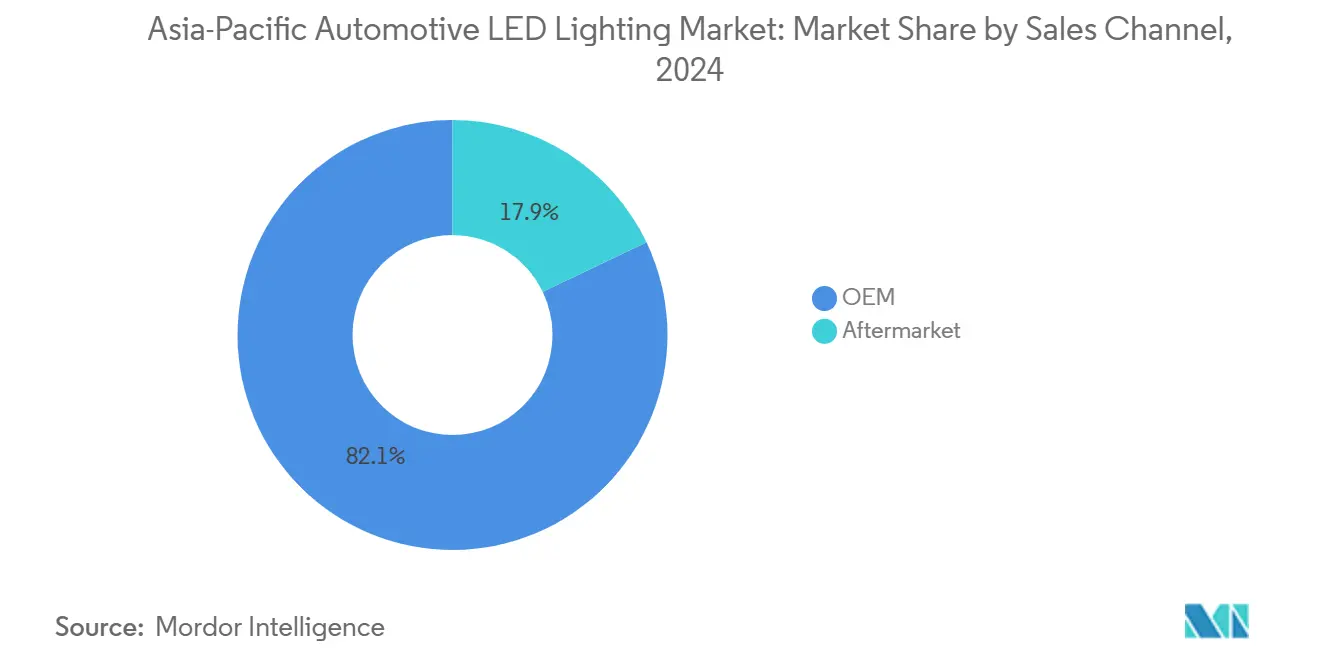
By Vehicle Type: Passenger Cars Retain Dominance, Two-Wheelers Surge
Passenger cars held 68.53% Asia Pacific automotive LED lighting market share in 2024 thanks to high build volumes and integrated ADAS lighting demand. The segment grows at 8.18% CAGR as electrified C-SUVs and sedans adopt dynamic signaling, Logo-projection lamps, and interior wellness lighting. Light commercial vans and urban delivery trucks climb steadily, propelled by e-commerce and mandatory daytime-running-lamp rules in China.
Two-wheelers, especially scooters, emerge as an electrification hotspot. Manufacturers embed power-efficient LEDs to stretch range, adding ambient strips and Bluetooth-controlled color cycles. Such features enhance brand differentiation in crowded urban corridors, lifting overall spend per vehicle and injecting new growth into the Asia Pacific automotive LED lighting market.
By Installation Type: Retrofits Narrow Gap with Factory Fitments
New installations still captured 61.37% revenue in 2024, dominated by factory-assembled headlamp, taillamp, and cluster modules. However, retrofit demand accelerates at 6.75% CAGR as workshop technicians adopt universal brackets, self-calibrating drivers, and mobile apps that guide beam-alignment checks. Insurance firms in India now discount premiums for LED conversions meeting AIS-008 standards, boosting penetration in older fleets.
Rising user familiarity and robust aftermarket warranties reduce perceived risk, drawing repeat buyers. Patent filings for wireless retrofit controllers illustrate the innovation pivot, underscoring retrofit momentum inside the Asia Pacific automotive LED lighting market.
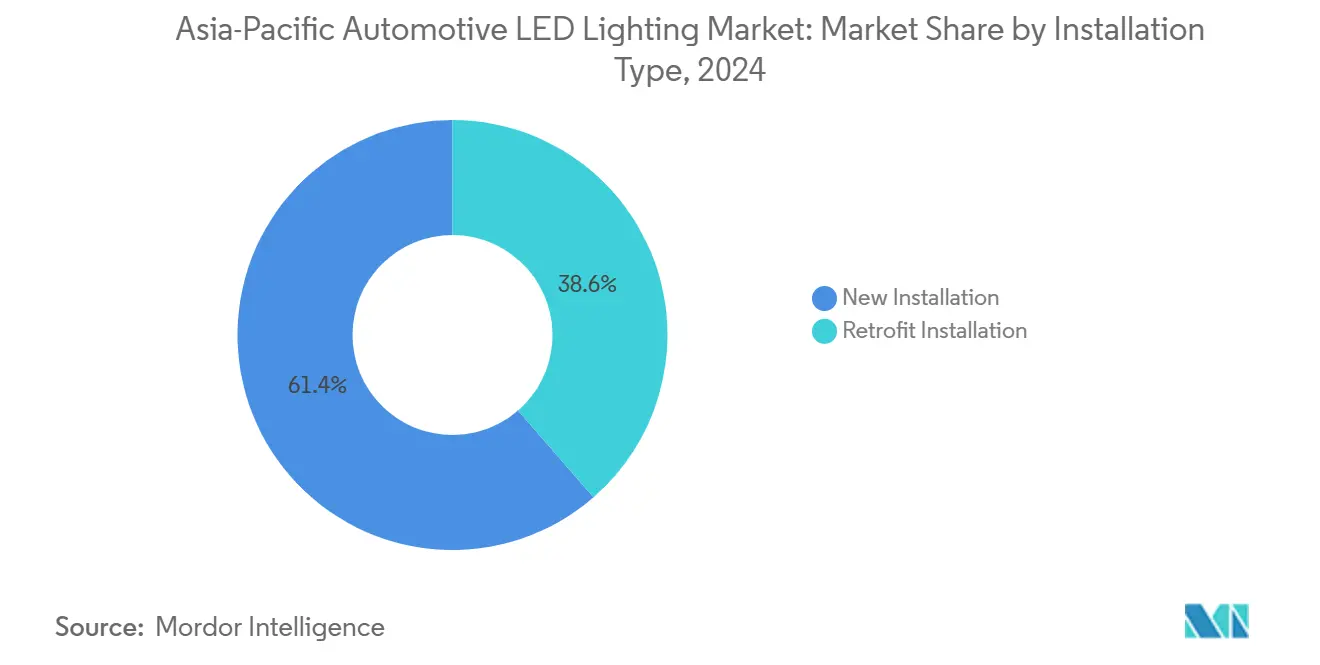
By Application: Interior Lighting Leads Premium Experience Wave
Exterior systems commanded 77.46% revenue in 2024, yet cabin lighting tops growth tables at 9.34% CAGR. Automakers layer RGB strips along dashboards, door trims, and footwells, syncing colors with drive modes and infotainment themes. Samsung-Hyundai’s 2024 partnership to co-develop wellness lighting highlights OEM appetite for differentiation.
Interior LEDs now integrate gesture sensors, UV-C sterilization, and circadian-friendly spectra. Suppliers that bundle optics, drivers, and software APIs secure multi-platform awards, cementing interior’s role as value creator in the Asia Pacific automotive LED lighting market.
Geography Analysis
China’s 35.84% share underscores its unrivaled production scale and policy support. Domestic packaging plants backed by the Big Fund lower cost per lumen, while EV penetration exceeding 85% catalyzes advanced lighting adoption. Rare-earth export controls heightened supply-chain vigilance but also steered manufacturers toward high-efficacy LEDs that minimize magnet use, reinforcing China’s leadership inside the Asia Pacific automotive LED lighting market.
India posts the region’s fastest 9.65% CAGR on the strength of two-wheeler electrification, AIS-008 regulation, and production-linked incentives that lure global suppliers. LED uptake in new scooters hit 70% in 2024, complementing fleet retrofits among ride-hail operators seeking lower maintenance spend. Domestic testing labs shorten homologation cycles, propelling local content growth and widening the Asia Pacific automotive LED lighting market footprint.
Japan and South Korea emphasize technology exports. Koito and Stanley spearhead matrix-LED deployments, while Samsung LED and LG Innotek leverage semiconductor fabs to supply premium clusters worldwide. Both countries nurture tight OEM-supplier integration and hold deep ADAS lighting IP portfolios that defend high margins. Meanwhile, ASEAN hubs,Thailand, Indonesia, Vietnam, attract lamp-module assembly as OEMs diversify risk. Incentive packages covering duty exemptions and infrastructure grants reposition these economies as critical nodes in the Asia Pacific automotive LED lighting market.
Competitive Landscape
The Asia Pacific automotive LED lighting market shows moderate concentration. The top five players, led by Koito, Stanley, Nichia, Valeo, and LG Innotek, collectively account for roughly 58% of regional revenue. These incumbents guard share through integrated optics-driver platforms, accredited test centers, and multi-decade OEM relationships. Japanese suppliers capitalize on unrivaled reliability records, securing long-cycle platform awards that discourage defection.
Mid-tier challengers, such as Samsung LED, Seoul Semiconductor, and Lumileds, leverage chip-level breakthroughs, including 200 lumens-per-watt emitters, to win high-efficacy programs in China and India. Strategic partnerships, such as Samsung-Hyundai’s ambient collaboration, illustrate a shift toward differentiation through software and wellness features.
Start-ups target retrofit niches with smartphone-controlled beam alignment and drop-in projector kits. Direct-to-consumer e-commerce models sidestep dealer networks, compressing prices yet preserving margins through scale. The need for UNECE and AIS-008 compliance serves as a protective moat, maintaining high-quality standards and containing counterfeit volumes within the Asia Pacific automotive LED lighting market.
Asia-Pacific Automotive LED Lighting Industry Leaders
Marelli Holdings Co., Ltd.
Stanley Electric Co., Ltd.
Valeo SA
ams-OSRAM AG
HELLA GmbH and Co. KGaA
- *Disclaimer: Major Players sorted in no particular order
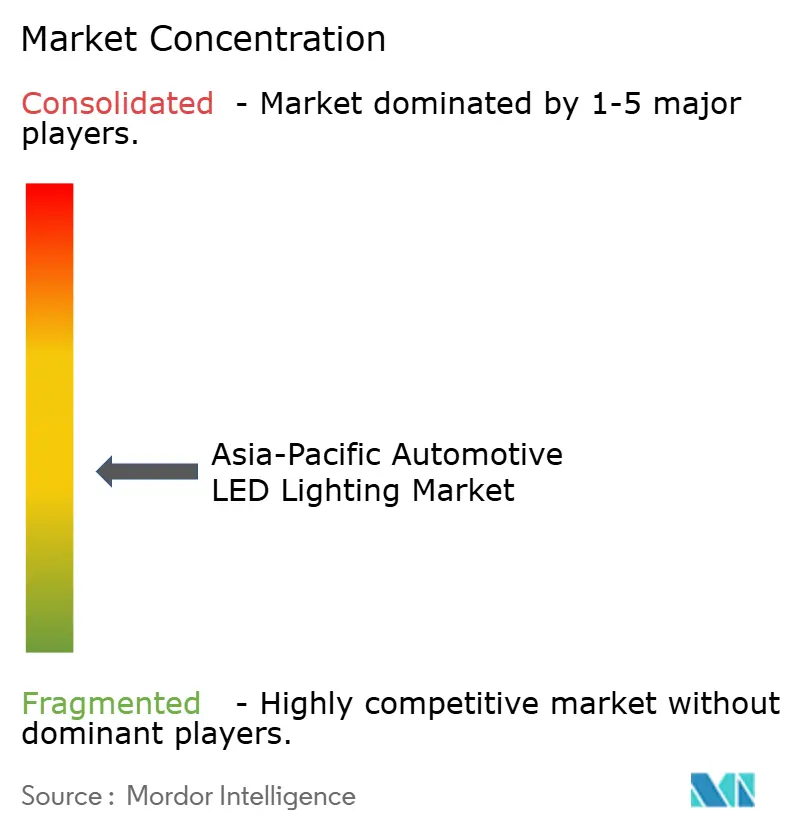
Recent Industry Developments
- August 2025: Sanan Optoelectronics agreed to acquire a 75% stake in Lumileds through a USD 239 million transaction aimed at expanding mid-to-high-end automotive LED capacity across Asia Pacific and adding overseas factories in Malaysia and Singapore.
- June 2025: Stanley Electric exhibited its next-generation factory-safety LED line-lights and drawing units at Manufacturing World Tokyo 2025, underscoring cross-industry LED expertise that feeds into its automotive product roadmap.
- May 2025: Infineon Technologies and Marelli unveiled an automotive-qualified MEMS laser-beam-scanning display module at Auto Shanghai 2025, targeting immersive cockpit projections with lower heat and power draw.
- April 2025: Valenti (Colant Co., Ltd.) launched a full-width LED tail-lamp assembly for the Mitsubishi Delica D:5 featuring continuous light-bar illumination and animated welcome/exit sequences for aftermarket personalization.
Asia-Pacific Automotive LED Lighting Market Report Scope
Daytime Running Lights (DRL), Directional Signal Lights, Headlights, Reverse Light, Stop Light, Tail Light, Others are covered as segments by Automotive Utility Lighting. 2 Wheelers, Commercial Vehicles, Passenger Cars are covered as segments by Automotive Vehicle Lighting. China, India, Japan, South Korea are covered as segments by Country.| OEM |
| Aftermarket |
| Passenger Cars |
| Light Commercial Vehicles |
| Heavy Commercial Vehicles |
| Two-Wheelers |
| New Installation |
| Retrofit Installation |
| Exterior Lighting | Headlamps |
| Daytime Running Lights | |
| Taillights | |
| Fog Lamps | |
| Turn Signals | |
| Other Exterior | |
| Interior Lighting | Dome and Map Lights |
| Ambient Lighting | |
| Instrument Cluster and Infotainment Backlighting | |
| Others Interior |
| China |
| India |
| Japan |
| South Korea |
| ASEAN |
| Rest of Asia-Pacific |
| By Sales Channel | OEM | |
| Aftermarket | ||
| By Vehicle Type | Passenger Cars | |
| Light Commercial Vehicles | ||
| Heavy Commercial Vehicles | ||
| Two-Wheelers | ||
| By Installation Type | New Installation | |
| Retrofit Installation | ||
| By Application | Exterior Lighting | Headlamps |
| Daytime Running Lights | ||
| Taillights | ||
| Fog Lamps | ||
| Turn Signals | ||
| Other Exterior | ||
| Interior Lighting | Dome and Map Lights | |
| Ambient Lighting | ||
| Instrument Cluster and Infotainment Backlighting | ||
| Others Interior | ||
| By Country | China | |
| India | ||
| Japan | ||
| South Korea | ||
| ASEAN | ||
| Rest of Asia-Pacific | ||
Market Definition
- INDOOR LIGHTING - It incorporates all LED based lamps and fixtures/luminaire that are used to illuminate indoor section of residential, commercial, industrial buildings and agricultural lighting. LED offers efficient brightness with higher durability in comparison to other lighting technology.
- OUTDOOR LIGHTING - It incorporates the LED lighting fixtures that is used for illumination for exterior/outdoor illumination. For instance, LED lighting fixtures used to illuminate streets and highways, transport hubs, stadiums and other public places such as parking spaces.
- AUTOMOTIVE LIGHTING - It refers to the lighting fixtures installed for illumination and signaling purposes. It is used in both exterior and interior lighting of the vehicle. Headlamps, fog lamp, daytime running light (DRLs) are examples of exterior light whereas cabin light are interior lights.
- END USER - It refers to the end use application area where the LED fixture will be installed. For instance, in terms of indoor lighting, we have residential, commercial and industrial as end user category. For automotive lighting, primary end user considered are automotive manufacturers and aftermarket sale
| Keyword | Definition |
|---|---|
| Lumen | Lumen is a unit of luminous flux in the International System of Units that is equal to the amount of light given out through a solid angle by a source of one-candela intensity radiating equally in all directions. |
| Footcandle | A foot-candle (or foot-candle, fc, lm/ft2, or ft-c) is a measurement of light intensity. One foot-candle is defined as enough light to saturate a one-foot square with one lumen of light. |
| Colour Rendering Index (CRI) | Color Rendering Index (CRI) is a measurement of how natural colors render under an artificial white light source when compared with sunlight. The index is measured from 0-100, with a perfect 100 indicating that colors of objects under the light source appear the same as they would under natural sunlight. |
| Luminous flux | Luminous flux is a measure of the power of visible light produced by a light source or light fitting. It is measured in lumens (lm). |
| Annual Energy Cost | Annual Energy Cost means the average daily energy consumption multiplied by 365 (days per year), expressed in kilowatt hour per year (kWh/a). |
| Constant voltage drivers | Constant voltage drivers are designed for a single direct current (DC) output voltage. Most common constant voltage drivers (or Power Supplies) are 12VDC or 24VDC. An LED light that is rated for constant voltage usually specifies the amount of input voltage it needs to operate correctly. |
| Constant Current Driver | Constant current LED drivers are designed for a designated range of output voltages and a fixed output current (mA). LEDs that are rated to operate on a constant current driver require a designated supply of current usually specified in milliamps (mA) or amps (A). These drivers vary the voltage along an electronic circuit which allows current to remain constant throughout the LED system. |
| Minimum Energy Performance Standards (MEPS) | Minimum Energy Performance Standards specify the minimum level of energy performance that appliances and equipment must meet or exceed before they can supply or used for commercial purposes. |
| Luminous Efficacy | Luminous efficacy is a measurement commonly used in the lighting industry that indicates the ability of a light source to emit visible light using a given amount of power. |
| Solid State Lighting | Solid-state lighting (SSL) is a type of lighting that uses semiconductor light-emitting diodes (LEDs), organic light-emitting diodes (OLED), or polymer light-emitting diodes (PLED) as sources of illumination rather than electrical filaments, plasma (used in arc lamps such as fluorescent lamps), or gas. |
| Rated Lamp Life | Lamp life, also referred to as rated life, is the time in hours a lamp will last before a percentage of lamps will burn out. |
| Color Temperature | Colour temperature is a scale that measures how ‘warm’ (yellow) or ‘cool’ (blue) the light from a particular source is. It is measured in degrees of the Kelvin scale (abbreviated to K), and the higher the number, the ‘cooler’ the light. The lower the ‘K’ number, the ‘warmer’ the light. |
| Ingress Protection rating (IP rating) | The IP (Ingress Protection) rating of a bulb or light fixture declares the level of protection it has against dirt and water. |
| Fidelity Index | The general colour fidelity index, Rf, represents how closely the colour appearances of the entire sample set are reproduced (rendered) on average by a test light as compared to those under a reference illuminant. |
| Gamut Index | The gamut area is defined as “the area enclosed by a set of test color samples illuminated by a light source, in a two-dimensional chromaticity diagram or a plane of color space.”1 Within a defined color space, a “gamut” describes the subset of colors that can be perceived under specific lighting conditions. |
| Binning | In the lighting industry, the act of "binning" of LEDs is the process of sorting LEDs by certain characteristics, such as color, voltage, and brightness. |
| Accent lighting | Accent lighting, also called highlighting, emphasizes objects by focusing light directly on them. Accent lighting is used inside and outside the home to feature locations such as an entrance or to create dramatic effects. |
| Dimmable driver | A dimming driver has two functions: As a driver, it converts the 230V AC mains input to a low voltage DC output. As a dimmer, it reduces the amount of electrical energy flowing to the LEDs, thereby causing them to dim. |
| Flicker | Flicker is the repeated and frequent variation in the output of a light source over time. |
| Fluorescent | A property of materials defined as the ability to emit light after absorbing electromagnetic radiation such as visible or UV light. |
| Candela | The candela is the unit of luminous intensity in the International System of Units. It measures the light output per unit solid angle emitted from a light source in a specific direction. |
| LUX | Lux is used to measure the amount of light output in a given area - one lux is equal to one lumen per square meter. It enables us to measure the total "amount" of visible light present and the intensity of the illumination on a surface. |
| Uniformity (U0) | The uniformity of lighting has significant effects on visual performance in both indoor and outdoor areas. Uniformity (represented as U0) value can be found by dividing the minimum brightness (Emin) resulting from calculations according to the current lighting order, to the average brightness value (Eavg). |
| Visible Light Spectrum | The visible light spectrum is the segment of the electromagnetic spectrum that the human eye can view. More simply, this range of wavelengths is called visible light. Typically, the human eye can detect wavelengths from 380 to 700 nanometers. |
| Ambient Temperature | Ambient Temperature is the temperature of the air surrounding an electrical enclosure. |
| Current-controlled dimming control | Current-controlled dimming controls LED brightness by varying the applied current using a 0-10V dimmer. Current-controlled dimming is smooth and HD-video friendly. It can only dim to a minimum of 5% of light output. |
| Design Light Consortium | It is a partnership of energy efficiency stakeholders in the United States and Canada to “promote quality, performance and energy efficient lighting solutions for the commercial sector”. |
| Pulse Width Modulation | Pulse-width modulation, or pulse-duration modulation, is a method of controlling the average power delivered by an electrical signal. |
| Surface Mounted Device | A surface mount device (SMD) is an electronic device whose components are mounted or placed directly on the surface of a printed circuit board. |
| Alternating Current | Alternating current is an electric current which periodically reverses direction and changes its magnitude continuously with time, in contrast to direct current, which flows only in one direction. |
| Direct Current | Direct current (DC) is an electric current that is uni-directional, so the flow of charge is always in the same direction. |
| Beam Angle | Beam angle (also called beam spread) is a measure of how light is distributed. On any plane perpendicular to the centerline of the light, the beam angle is the angle between two rays where the light intensity is 50% of the maximum light intensity. |
| LED Based Solar High Mast Lighting Systems | A Solar LED High Mast Light is a raised source of High illumination lights (6~8 lights) and with high intensity on the middle of major junctions (Ring roads, Outer Ring roads), turned on or lit automatically in the absence of light (at specified timings or at periodic times, every night). |
| Surface Mounted Diode (SMD) LEDs | A surface mount diode is a type that emits light and is flat mounted and soldered onto a circuit board. |
| Chip on Board (COB) LEDs | A COB LED is basically multiple LED chips (usually 9 or more) glued directly onto a substrate by the manufacturer to form a single module. |
| Dual In-Line Package (DIP) LEDs | A dual in-line package (DIP or DIL) is an electronic component package with a rectangular case and two parallel rows of electrical connector pins. |
| Graphene LED Lights | A graphene LED light bulb is simply an LED light bulb where the filament has been coated in graphene. A graphene LED bulb is reported to be 10% more efficient than regular LED light bulbs and they are cheaper to manufacture and buy. |
| LED Corn Bulbs | LED Corn lights are designed as an energy efficient alternative to high intensity discharge (HID) and SON lamps. It uses a large number of LEDs on a metal structure to provide sufficient light. This arrangement of LEDs looks a lot like a corn cob, hence the name "corn light". |
| Per Capita Income | Per capita income or total income measures the average income earned per person in a given area in a specified year. It is calculated by dividing the area's total income by its total population. Per capita income is national income divided by population size. |
| Charging Stations | A charging station, also known as a charging station or electric vehicle utility, is a power supply that provides electrical energy for charging plug-in electric vehicles. |
| Headlight | A headlight is a light that is mounted on the front of a car and illuminates the road in front of it. Low beam and high beam LED headlights are additional categories for these LED headlights. |
| Day Time Running Light (DRLs) | A daytime running lamp is a white, yellow, or amber lighting device mounted on the front of a road-going motor vehicle or bicycle. |
| Directional Signal Light | Directional signal lights are the front and rear lights on an automobile that flash to show the direction of a turn. |
| Stop Light | A red light that is mounted to the back of a car and turns on when the brakes are used to show that the car is stopped. |
| Reverse Light | The reverse light is at the back of the vehicle to indicate its backward motion. |
| Tail Light | A red light that can be seen in the dark is mounted on the rear of a road vehicle. Stop, reverse, and directional signal lights are all part of it. |
| Fog Light | Bright lights in automobiles used to increase visibility on the road in foggy conditions or to warn other drivers of the presence of the vehicle. |
| Passenger Vehicle | A passenger vehicle is a road vehicle, other than a moped or a motorcycle, intended for the transportation of people and designed for up to 8 to 9 seats. |
| Commercial Vehicle | A commercial vehicle (Bus, Truck, Van) is any type of motor vehicle used to transport goods or pay passengers. |
| Two Wheelers (2W) | A two-wheeler is a vehicle that runs on two wheels. |
| Streets & Roadways | Both roads and streets refer to hard, flat surfaces on the ground on which vehicles, people, and animals can travel. Since streetways are usually in cities and towns, they often have houses and buildings on both sides. The roadway is in the countryside and sometimes passes through forests and fields |
| Horticulture Lighting | Horticulture is the science and art of sustainably growing, producing, marketing and using high quality, intensively cultivated food and ornamental plants. |
Research Methodology
Mordor Intelligence has followed the following methodology in all our data center reports.
- Step 1: Raw Data Collection: To understand the market, initially, all crtical data points were identified. Critical information about countries and regions of interest including Per-capita Income, Population, Automotive Production, Interest rate on Auto-Loans, Number of Automobiles on Road, Total LED Import, Lighting Electricity Consumption among others were recorded or estimated based on internal calculations.
- Step 2: Identify Key Variables: To build a robust forecasting model, key variables such as Number of Households, Automotive Production, Road Networks among others were identified. Through an iterative process, the variables required for the market forecast were set, and the model was built using these variables.
- Step 3: Build a Market Model: Based on data and critical industry trend data (variables), including LED pricing, LED penetration rate, and project macro and micor economic factors were utilized for building the market forecasting.
- Step 4: Validate and Finalize: In this crucial step, all market numbers and variables derived through an internal mathematical model were validated through an extensive network of primary research experts from all the markets studied. The respondents are selected across levels and functions to generate a holistic picture of the market studied.
- Step 5: Research Outputs: Syndicated Reports, Custom Consulting Assignments, Databases & Subscription Platforms
